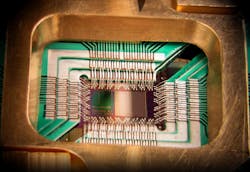Working With Quantum Computing
What you’ll learn:
- What is TKET?
- How to give quantum computing a "test drive."
Okay, quantum computing isn’t something you’ll be doing in the near future, unless you’re in a university or company specializing in the technology, since the actual hardware isn’t ready to put into your pocket smartphone—yet. For example, D-Wave Systems’ 128-qubit superconducting adiabatic quantum optimization processor needs the supporting equipment to maintain operating temperature (see figure).
If these quantum computers ran like conventional processors, then one might simply take their C program and drop it on a quantum computer. Unfortunately, that doesn’t work.
Luckily, though, developers can utilize tools like Cambridge Quantum’s (CQ) TKET (pronounced “ticket”) quantum software-development kit to not only target quantum-computing hardware, but also program and run applications suitable for quantum computing in software. Getting hands-on experience can be very useful in understanding what is doable and how it will be programmed.
The free, open-source TKET allows developers to translate algorithms into quantum circuits. The resulting applications can be used with a range of quantum hardware platforms and quantum programming tools without needing to rewrite code.
TKET has been around since 2018, but it just recently moved to open source. It is platform-agnostic and will work with most commercially available quantum hardware platforms. This includes hardware from companies like Google, Honeywell, IBM, and IonQ. TKET also works with open-source quantum programming tools such as Cirq, Qiskit, and Pennylane.
Algorithms and Qubits
It can be a challenge to develop algorithms that work with the physical qubit layouts of each individual platform. TKET helps translate machine-independent algorithms into executable circuits. The circuits are then optimized for the precise qubit layout of each platform. This process reduces the number of steps needed to run an algorithm. It ensures the results and outputs are as reliable as possible, even when using noisy intermediate-scale quantum (NISQ) devices.
NISQ is the name of the game these days since qubits inside today’s quantum hardware are unstable and quickly become “noisy.” They can lose coherence and stop producing clear results when running an algorithm.
Back in May, researchers from CQ developed a quantum algorithm that helps solve problems involving the complex Monte Carlo integration. Monte Carlo is a mathematical process used to estimate the probability of averaging samples; it’s critical in financial risk analysis, drug development, supply-chain logistics, and throughout other business and scientific applications. TKET software also was used in a further breakthrough—CQ was able to show “ground-breaking proofs” that quantum computers can learn to apply reason when faced with partial information or uncertainty.
“TKET combines high-level hardware-agnostic optimization for quantum circuits with target specific compilation passes for the chosen quantum device,” said Dr. Ross Duncan, Head of Software at CQ. “This helps quantum computing users move seamlessly between quantum platforms, while maintaining consistent high performance. Users need only to focus on developing their quantum applications, not rewriting code around the idiosyncrasies of any particular hardware. At the same time, we help quantum-computing hardware companies ensure that they can get the best performance from their processors.”
Quantum computing is new, but it offers many opportunities much like the way machine learning has gone from an academic exercise to incorporation in a wide range of applications.
About the Author
William G. Wong
Senior Content Director - Electronic Design and Microwaves & RF
I am Editor of Electronic Design focusing on embedded, software, and systems. As Senior Content Director, I also manage Microwaves & RF and I work with a great team of editors to provide engineers, programmers, developers and technical managers with interesting and useful articles and videos on a regular basis. Check out our free newsletters to see the latest content.
You can send press releases for new products for possible coverage on the website. I am also interested in receiving contributed articles for publishing on our website. Use our template and send to me along with a signed release form.
Check out my blog, AltEmbedded on Electronic Design, as well as his latest articles on this site that are listed below.
You can visit my social media via these links:
- AltEmbedded on Electronic Design
- Bill Wong on Facebook
- @AltEmbedded on Twitter
- Bill Wong on LinkedIn
I earned a Bachelor of Electrical Engineering at the Georgia Institute of Technology and a Masters in Computer Science from Rutgers University. I still do a bit of programming using everything from C and C++ to Rust and Ada/SPARK. I do a bit of PHP programming for Drupal websites. I have posted a few Drupal modules.
I still get a hand on software and electronic hardware. Some of this can be found on our Kit Close-Up video series. You can also see me on many of our TechXchange Talk videos. I am interested in a range of projects from robotics to artificial intelligence.


